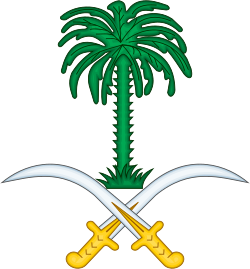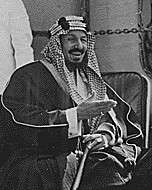Turki I bin Abdulaziz
Turki I bin Abdulaziz Al Saud (Arabic: تركي الأول بن عبد العزيز آل سعود, Turkī l-ʾAwwal bin ʿAbd al-ʿAzīz Āl Saʿūd) (1900–1919) was the eldest son of Ibn Saud of Saudi Arabia. He accompanied his father during the conquest of the Arabian Peninsula at a young age, and witnessed battles in Kuwait and al-Hasa. He died in 1919 in the 1918-1920 flu pandemic, which also killed many others in the region, including his half-brother Saad (I), who was the younger full-brother of King Faisal and his younger full-brother Prince Fahd (I).
| Turki I bin Abdulaziz | |||||
|---|---|---|---|---|---|
| Crown Prince of Najd and Hejaz | |||||
| Crown Prince of Najd and Hejaz | |||||
| In office | 1902–1919 | ||||
| Predecessor | Post established. | ||||
| Successor | Saud | ||||
| Monarch | Abdulaziz bin Abdul Rahman | ||||
| Born | 1900 Kuwait City, Sheikhdom of Kuwait | ||||
| Died | 1919 (aged 18–19) Riyadh, Emirate of Nejd and Hasa | ||||
| Spouse |
| ||||
| Issue | Prince Faisal bin Turki, Hes'sa bint Turki | ||||
| |||||
| House | House of Saud | ||||
| Father | Ibn Saud | ||||
| Mother | Wadhah bint Muhammad bin 'Aqab | ||||
Early life
Turki al Awwal was the eldest son of Ibn Saud.[1][2] His mother was Wadhah bint Muhammad bin 'Aqab, who belonged to the Bani Khalid tribe.[3] She was the daughter of the chief of the Bani Khalid tribe, who ruled al-Hasa[2] and was Ibn Saud's second wife.[4] They married in 1896.[5] Turki's birthplace is Kuwait City. He was born in 1900 when his family was in exile there.[6]
Turki was full-brother of King Saud. His full sisters include Munira and Noura.[4][7]
Activities and succession
Prince Turki was the deputy of his father as commander-in-chief of the army.[8] During his lifetime, Turki al Awwal was the Crown Prince of Najd, his father's domain until then. He was Crown Prince beginning by his father's conquest of Riyadh on 15 January 1902 up to his own early death in 1919. The Saudi custom of succession stipulates that kings be succeeded by their younger brothers, in seniority of age, rather than by their sons.[9] Therefore, at Turki's death, his next brother Saud became crown prince, rather than his son Faisal. Saud later became king and was overthrown by another of his brothers, not by one of his sons.
Personal life
Turki I's first wife gave birth to his son Faisal bin Turki. Years later, Faisal bin Turki became minister of interior in the government of King Saud from 1961 to 1962.[10] Faisal bin Turki died in 1968 in Riyadh, and had a daughter named Sara who married the former governor of Najran province, Mishaal bin Saud. Turki also had a daughter with his other wife Tarfa Al Mhanna, Hes'sa bint Turki, who was the wife of Abdulaziz bin Faisal bin Abdulaziz, and they had two sons, Faisal and Turki.[11] Princess Hes'sa died in Riyadh at the age of 91 on 19 August 2007 and was buried in Al Oud cemetery.[12]
Two grandsons of Turki I, the children of his son Faisal, have served on the Allegiance Council: Turki bin Faisal,[13] (until his death on 28 February 2009)[14] and Abdullah bin Faisal (until his death in February 2019).[15]
Death
Turki al Awwal died in Riyadh during the flu pandemic that killed his mother and many others in the region in 1919.[9][16][17] His father was said to be deeply saddened by his death.[18]
After the death of Turki, his wife, Noweir bint Obaid Al Rasheed, married his younger brother Saud, and they had a daughter, named Al Anoud bint Saud.[18]
Ancestry
| Ancestors of Turki I bin Abdulaziz | |||||||||||||||||||||||||||||||||||||||||||||||||||||||||||||||||||||||||||||||||||||||||||||||||||||||||||||||||||||||||||||||||||||||||||||||||||||||||||||||||||||||||||||||||||||||||||||||||||||||||||||||||||||||||||||||||||||||||||||||||||||||||||||||||||||||||||||||||||||||||||||||||||||||||||||||||||||||||||||||||||||||||||||||||||||||||||||||||||||||||||||||||||||||||||||||||||||||||||||||||||||||||||||||||||||||||||||||||||||||||||||||||||||||||||||||||||
|---|---|---|---|---|---|---|---|---|---|---|---|---|---|---|---|---|---|---|---|---|---|---|---|---|---|---|---|---|---|---|---|---|---|---|---|---|---|---|---|---|---|---|---|---|---|---|---|---|---|---|---|---|---|---|---|---|---|---|---|---|---|---|---|---|---|---|---|---|---|---|---|---|---|---|---|---|---|---|---|---|---|---|---|---|---|---|---|---|---|---|---|---|---|---|---|---|---|---|---|---|---|---|---|---|---|---|---|---|---|---|---|---|---|---|---|---|---|---|---|---|---|---|---|---|---|---|---|---|---|---|---|---|---|---|---|---|---|---|---|---|---|---|---|---|---|---|---|---|---|---|---|---|---|---|---|---|---|---|---|---|---|---|---|---|---|---|---|---|---|---|---|---|---|---|---|---|---|---|---|---|---|---|---|---|---|---|---|---|---|---|---|---|---|---|---|---|---|---|---|---|---|---|---|---|---|---|---|---|---|---|---|---|---|---|---|---|---|---|---|---|---|---|---|---|---|---|---|---|---|---|---|---|---|---|---|---|---|---|---|---|---|---|---|---|---|---|---|---|---|---|---|---|---|---|---|---|---|---|---|---|---|---|---|---|---|---|---|---|---|---|---|---|---|---|---|---|---|---|---|---|---|---|---|---|---|---|---|---|---|---|---|---|---|---|---|---|---|---|---|---|---|---|---|---|---|---|---|---|---|---|---|---|---|---|---|---|---|---|---|---|---|---|---|---|---|---|---|---|---|---|---|---|---|---|---|---|---|---|---|---|---|---|---|---|---|---|---|---|---|---|---|---|---|---|---|---|---|---|---|---|---|---|---|---|---|---|---|---|---|---|---|---|---|---|---|---|---|---|---|---|---|---|---|---|---|---|---|---|---|---|---|---|---|---|---|---|---|---|---|---|---|---|---|---|---|---|---|---|---|---|---|---|---|---|---|---|---|---|---|---|---|---|---|---|---|---|---|---|---|---|---|---|---|---|---|---|---|---|---|---|---|---|---|---|---|---|---|---|---|---|---|---|---|---|---|---|---|---|---|---|---|---|---|---|---|---|---|
| |||||||||||||||||||||||||||||||||||||||||||||||||||||||||||||||||||||||||||||||||||||||||||||||||||||||||||||||||||||||||||||||||||||||||||||||||||||||||||||||||||||||||||||||||||||||||||||||||||||||||||||||||||||||||||||||||||||||||||||||||||||||||||||||||||||||||||||||||||||||||||||||||||||||||||||||||||||||||||||||||||||||||||||||||||||||||||||||||||||||||||||||||||||||||||||||||||||||||||||||||||||||||||||||||||||||||||||||||||||||||||||||||||||||||||||||||||
References
- James Wynbrandt (2010). "A" Brief History of Saudi Arabia. Infobase Publishing. p. 184. ISBN 978-0-8160-7876-9. Retrieved 3 April 2013.
- George Kheirallah (1952). Arabia Reborn. Albuquerque: University of New Mexico Press. p. 254. Retrieved 14 March 2015. – via Questia (subscription required)
- "تحقيق سلسة نسب والدة الملك سعود بن عبدالعزيز آل سعود" [The achievements of the mother of King Saud bin Abdulaziz Al Saud] (in Arabic). March 2011. Retrieved 27 April 2013.
- "Ibn Saud marries for a second time". Information Source. Archived from the original on 8 April 2013. Retrieved 3 April 2013.
- "Appendix A Chronology of the Life of Ibn Saud" (PDF). Springer: 197. Retrieved 5 August 2020.
- Bernard Reich (1990). Political leaders of the contemporary Middle East and North Africa: a biographical dictionary. Greenwood Publishing Group. p. 16. ISBN 978-0-313-26213-5.
- Mai Yamani (January–March 2009). "From fragility to stability: a survival strategy for the Saudi monarchy" (PDF). Contemporary Arab Affairs. 2 (1): 90–105. doi:10.1080/17550910802576114. Archived from the original (PDF) on 16 September 2013. Retrieved 5 April 2012.
- "Ibn Saud's eldest son, Prince Turki, dies in influenza epidemic". Information Source. Archived from the original on 1 February 2015. Retrieved 11 April 2013.
- Henderson, Simon (1994). "After King Fahd" (Policy Paper). Washington Institute. Retrieved 2 February 2013.
- Yitzhak Oron, Ed. Middle East Record Volume 2, 1961. The Moshe Dayan Center. p. 419. GGKEY:4Q1FXYK79X8. Retrieved 11 April 2013.
- "تركي بن عبدالعزيز ( 1318-1337 هـ )- ( 1900-1919 م )". King Saud Official website. Retrieved 21 September 2013.
- "Princess Hissah bint Turki dies". Sauress. 19 August 2007. Retrieved 13 April 2013.
- "King Abdullah names members of the Allegiance Commission". Royal Embassy of Saudi Arabia Washington D.C. Archived from the original on 1 June 2012. Retrieved 6 April 2012.
- "Political reforms and the succession dilemma in Saudi Arabia" (PDF). Archived from the original (PDF) on 22 September 2013. Retrieved 6 April 2012.
- "Saudi succession developments" (PDF). Foreign Reports Inc. 28 October 2011. Retrieved 25 April 2012.
- Mark Weston (28 July 2008). Prophets and Princes: Saudi Arabia from Muhammad to the Present. John Wiley & Sons. p. 129. ISBN 978-0-470-18257-4. Retrieved 27 February 2013.
- Jennifer Reed (1 January 2009). The Saudi Royal Family. Infobase Publishing. p. 30. ISBN 978-1-4381-0476-8. Retrieved 2 April 2013.
- "الملك سعود بن عبد العزيز". King Saud website. Retrieved 27 April 2013.

